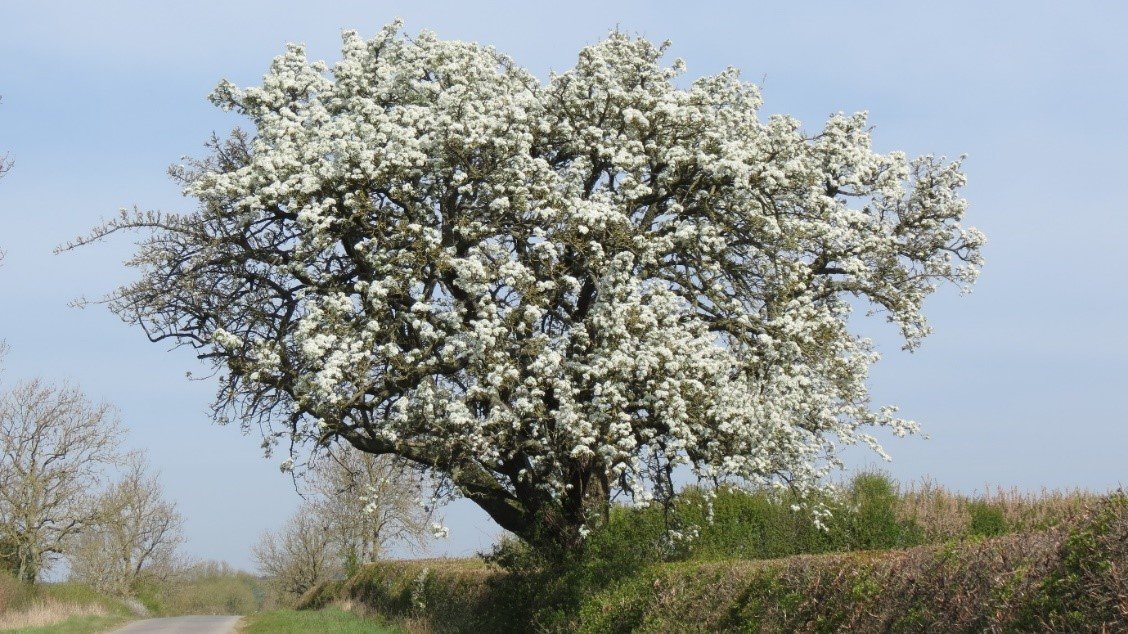Have yourself a perry Christmas…
Warwickshire pears – were they used in a festive drink?
A few years ago, I began to notice some old pear trees in local hedgerows and these were particularly concentrated around the village of Whatcote (near Shipston on Stour). They are spectacular when flowering and produce small pears of different shapes, sizes and colours. The area is mentioned in a couple of books, one of which is Richard Mabey’s Flora Britannica, as being ‘known’ for its pear trees. In Flora Britannica there is a reference: ‘In the parish of Whatcote, Warwickshire, there are some 20 mature pear trees, not in an orchard, but spread out over several hundred acres of farmland in hedgerows. Apparently, the village was noted for its perry, made from the fruit’. In Unknown Warwickshire (1. Mary Dormer Harris, 1924) the area is referred to as ‘the Warwickshire wild pear country’.
A favourite pear tree in full blossom
This spring a friend and I decided to locate as many of the pear trees as we could and we did this during our walks, drives and cycle rides in the area. We also used Google Earth, as the images of the area were helpfully taken at the time the trees were flowering, although there is the possibility of some confusion with blackthorn. We located more than 20 trees and have all their information in a spreadsheet, including their precise locations. There are a few more trees to follow up next year.
In September we visited all the trees to collect samples of fruit and this entailed identifying and contacting the various landowners. All were happy for us to collect the fruit and some helped us! We took the fruit to the Malvern Autumn Show to show to the perry pear expert, Jim Chapman (National Perry Pear Centre – Conserving a part of our orchard heritage), who had a stand there. Jim inspected all the fruit, identified a couple of samples as being from ‘wild’ trees and told us that none of the other samples were ‘recognised’ perry pear varieties. However, he suggested we should taste them all – especially to identify the presence of tannins (needed for perry) – and that, if we wanted to, we could name them as ‘varieties’. Before we could name the trees we would have to get their DNA analysed to check they really weren’t an existing named variety fruitID | Apple Identification | Apple Varieties | Apple Cultivars. We tasted all the samples and recorded the information in the spreadsheet. The various pears do taste very different and a few are really nice.
A selection of our pear samples
Perry pears were/are mainly grown in Gloucestershire/Herefordshire/Worcestershire and part of Monmouthshire and this is where most of the wonderfully-named varieties (see photo below) come from. The National Perry Pear collection in Gloucestershire was primarily established to provide a living botanical collection of perry pear fruit trees and a genetic resource for the nation. There are some good sources of information on perry pears, although they are few in number. Most of them are referred to on the web site hosted by the National Perry Pear Centre and some are available in their entirety, including Charles Martell’s excellent and fairly recent book 2012 Martell Perry Pears.pdf - OneDrive (live.com). I also recently managed to borrow an excellent earlier study produced by the University of Bristol in 1963 entitled ‘Perry Pears’ and published for the National Fruit and Cider Institute.
Samples from the National Perry Pear collection displayed at the Malvern Autumn Show
I’m now investigating the history of these pear trees and perry/cider making, including the production of a ‘harvest’ cider made of pears and crab apples. I’ve sought assistance from the Mid-Shires Orchard Group (MSOG) (20+) Mid Shires Orchard Group | Facebook which aims to conserve and promote the heritage apples, local orchards and 'top fruit' traditions of Buckinghamshire, Northamptonshire, Oxfordshire and Warwickshire. According to the current Chair, one of the Group's founder members did some research into the history of cider-making in south Warwickshire a few years ago. She recalls him saying that there is documentary evidence of the practice dating back to around the 12th or 13th centuries and that a local fermented drink was made from a mixture of apples and pears. She thinks that he called this 'Crab John'. I’m hoping that the group will be able to provide some more information to help us. A couple of people have also told us that pear wood was used to make ploughs because it is so hard.
If you have any information about these pear trees and how the fruit was used I would be very pleased to hear from you and you can contact me here: rosemary.collier@warwick.ac.uk.
1. Mary Dormer Harris was born in Stoneleigh, Warwickshire and she wrote and published books and plays, lectured in local history at the University of Birmingham and was Vice-President of the Workers’ Education Association and an associate of the Dugdale Society. She was an ardent suffragist, one of the first female members of the Leamington Literary Society and a founder member of the Loft Theatre. Mary Dormer Harris, 1867 – 1936 | Leamington History Group
Rosemary Collier
Biography: Rosemary Collier is a Professor in the School of Life Sciences and an Academic Lead of the Food Global Research Priority (GRP). Rosemary trained as an entomologist and has worked on the pest insects of horticultural crops for many years. She is particularly interested in using science to address problems in the horticultural industry. She is also interested in the wider aspects of food production and consumption and in recent years has collaborated with colleagues from a range of disciplines (sociology, geography, statistics, engineering, theatre studies) on projects associated with food and food security.




